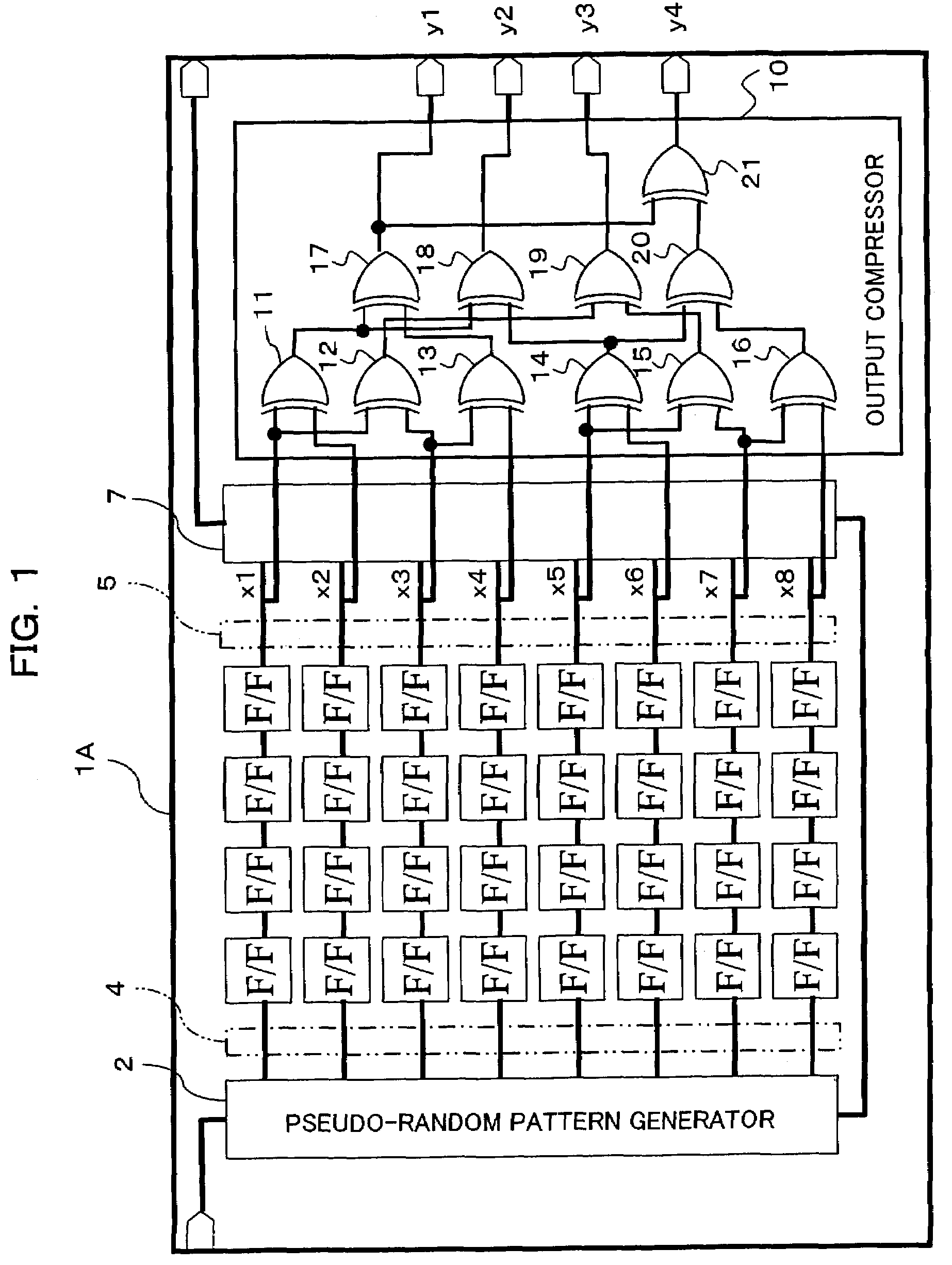Apparatus and method for diagnosing integrated circuit
a technology of integrated circuits and diagnostic methods, applied in the direction of error detection/correction, power supply testing, instruments, etc., can solve the problems of large increase in complexity of creation of test patterns, lsi is called, and defects inside lsi, so as to shorten the test time for the integrated circuit, increase the number of scan paths, and accurately specify all scan paths
- Summary
- Abstract
- Description
- Claims
- Application Information
AI Technical Summary
Benefits of technology
Problems solved by technology
Method used
Image
Examples
first embodiment
[0045]1 Description of First Embodiment
[0046]For fault diagnosis, agreement / disagreement information (information on whether a scan path output agrees with an expected value for each test pattern) for each test pattern is necessary, like DSPT. Since a scan path output is not compared with an expected value for each test pattern in BIST, it is necessary to read values of F / Fs for each test pattern to the outside. However, the number of inside parallel scan paths is increased for the purpose of a high-speed test in BIST, so that external output pins in number equal to all scan paths cannot be prepared because of limitation of the number of input / output pins of an LSI. Accordingly, some measures are necessary to compress information of a number of scan paths and observe it at a small number of external output pins. A first embodiment of this invention provides such measures.
[0047]FIG. 1 is a block diagram showing a structure of a diagnosing apparatus for an integrated circuit according...
second embodiment
[0068]2 Description of Second Embodiment
[0069]When a plurality of faults concurrently occur, it is impossible to specify positions of the faults in the above first embodiment. This easily occurs when a new manufacturing process is started, thus necessity of fault diagnosis is large. According to second and third embodiments, it becomes possible to accurately specify all scan paths in which faults occur as necessary.
[0070]FIG. 3 is a block diagram showing a structure of a diagnosing apparatus for an integrated circuit according to the second embodiment of this invention. As shown in FIG. 3, the diagnosing apparatus according to the second embodiment comprises a pseudo-random pattern generator 2, a plurality of scan paths, and an output verifier 7 similar to those according to the first embodiment, along with an output selector 30 instead of the output compressor 10. The diagnosing apparatus is built in an LSI 1B that is an integrated circuit to be tested.
[0071]Like the LSI 1A accordi...
third embodiment
[0086]3 Description of Third Embodiment
[0087]FIG. 4 is a block diagram showing a structure of a diagnosing apparatus for an integrated circuit according to a third embodiment of this invention. As shown in FIG. 4, the diagnosing apparatus according to the third embodiment comprises a pseudo-random pattern generator (LFSR) 2, a plurality of scan paths (shift registers) and an output verifier (MISR) 7 similar to those according to the first or second embodiment, along with a pattern modifier 4 similar to that according to the first embodiment between the pseudo-random pattern generator 2 and the plural scan paths, and a mask 5 similar to that according to the first embodiment between the plural scan paths and the output verifier 7. The diagnosing apparatus is built in an LSI 1C that is an integrated circuit to be tested.
[0088]Like the LSI 1A according to the first embodiment, the LSI 1C includes a plurality of F / Fs (sequential circuit elements). In the LSI 1C, the F / Fs form a pluralit...
PUM
 Login to View More
Login to View More Abstract
Description
Claims
Application Information
 Login to View More
Login to View More - R&D
- Intellectual Property
- Life Sciences
- Materials
- Tech Scout
- Unparalleled Data Quality
- Higher Quality Content
- 60% Fewer Hallucinations
Browse by: Latest US Patents, China's latest patents, Technical Efficacy Thesaurus, Application Domain, Technology Topic, Popular Technical Reports.
© 2025 PatSnap. All rights reserved.Legal|Privacy policy|Modern Slavery Act Transparency Statement|Sitemap|About US| Contact US: help@patsnap.com



